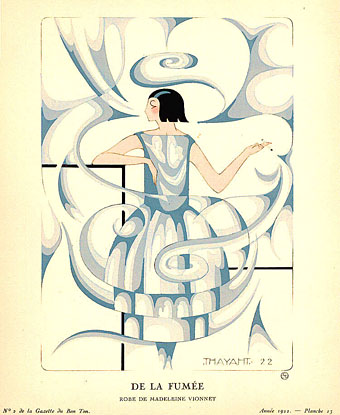De la Fumée (1922).
Artophile has a page of prints by Thayaht, a palindromic pseudonym concealing the identity of Italian artist Ernesto Michahelles whose fashion illustration differs from many of his contemporaries in its Futurist influence. I really like the stylisation of some of these, the way they’re caught midway between representation and abstraction. As well as illustrating, painting and sculpting, Thayaht worked as a designer and in 1919 created a one-piece “futurist garment” which he called the TuTa; you can see him wearing it here.
• THAYAHT – RAM
• A gallery of Thayaht art
Elsewhere on { feuilleton }
• The illustrators archive
Previously on { feuilleton }
• The Mentor
• The art of Cassandre, 1901–1968
• Smoke
• The Decorative Age
• The World in 2030


Lovely works. The TuTa is another example of the sort of clothing other constructivists were doing around the same time. Their aims of creating utilitarian and affordable clothing that freed the body were good, it’s just a shame that frequently they were so unattractive! Thayaht looks quite spiffy in his TuTa though. Even with sandals and socks…
He might have coined the word: Nowadays “tutta” is normally used for any one piece garment, be it work or diving gear.
These are fascinating – Vionnet, too!
There were a couple of examples of the sort of revised clothing designs The Other Andrew mentions at the very patchy V&A’s Modernism show in 2006, including the same photograph of Thayaht looking spiffy in his TuTa, and a reconstruction of a much less attractive outfit designed by Rodchenko.
http://www.vam.ac.uk/vastatic/microsites/1331_modernism/highlights_16.html
I hesitate to say it, but the TuTa looks very Italian, and the Rodchenko outfit looks very, well, Russian. Why are the trousers so short?
I’d seen Rodchenko’s design before but the TuTa was a new one for me. I can’t imagine it catching on in fashion-conscious Italy somehow. And I didn’t know that about “tutta”, Nathalie. He seemed fond of these neologisms, there’s also “taiattite” which Wikipedia describes as “a silver and aluminum alloy with which he made primitive fashionable pendants.”
And in a similar vein, behold the Futurist suit! The perfect thing for a voyage on a Dazzle Ship.
Thanks very much John. I thought there was something oddly familiar about these. I believe they were published in the magazine. (I *think* there is another collection of these with better quality images somewhere around but they are proving elusive at the mo’)
OOps. ==>..published in the Gazette du Bon Ton magazine.
Oh, great link, thanks for that. Good seeing them in situ and the other pages are worth looking at as well.